Broad-toothed Rat
Broad-toothed RatMastacomys fuscus mordicus | |
|---|---|
| Kingdom: | Animalia |
| Phylum: | Chordata |
| Class: | Mammalia |
| Order: | Rodentia |
| Family: | Muridae |
| Status | |
| World: | Near threatened (IUCN |
| Australia: | Vulnerable EPBC Act 1999 |
| Victoria: | Vulnerable (FFG Threatened List 2025) |
| NSW: | Vulnerable (TSC Act 1995) |
| Profiles | |
| Australia: | Species profile threats database |
| FFG | Action Statement 2023 |
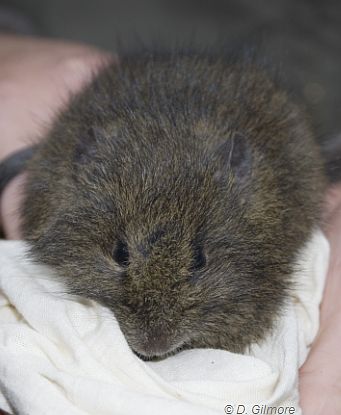
Broad-toothed Rat.
The Broad-toothed Rat Mastacomys fuscus is a native rodent herbivore of south-eastern Australia found in high rainfall areas containing a dense ground layer of grasses, sedges, herbs and heaths.
Two sub-species are recognised;
- Mastacomys fuscus mordicus ; with populations in New South Wales and Victoria.
- Mastacomys fuscus fuscus; occurring in Tasmania where it is known as the Broad-toothed Mouse or Tooarrana by the Indigenous people of Tasmania. (CSIRO 1995; Plomley 1976).
As its name implies, the Broad-toothed Rat has wide incisors and molar teeth. It has a body length between 140 – 195mm with a tail length of 95 – 135mm. It has a rotund build with a hunched posture, sandy brown to dark brown dense fur, long under fur, with black guard hairs on the back. The under surface is pale grey to buff-grey. The ears are rounded, appearing almost naked but are covered with tiny sandy brown hairs. The tail is relatively short (less than head & body length) and uniformly dark brown, scaled with sparse dark grey short hairs. Feet are dusky brown, above and below. Scats have a bright green colour. (Description refs.; Happold, 1983; Menkhorst 2001; Wallis et al. 1982).
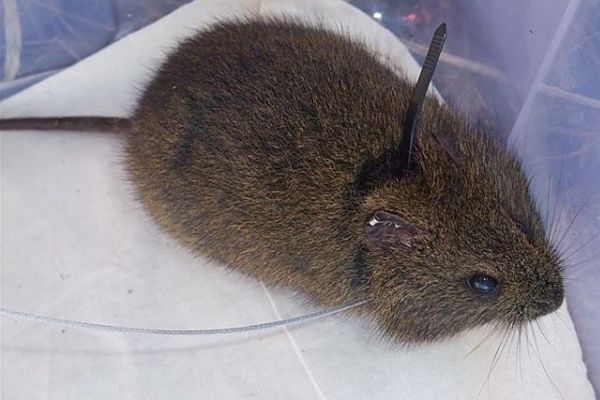
Broad-toothed Rat with radio tracking collar; Image courtesy Mt Buller - Mt Stirling Resort Management
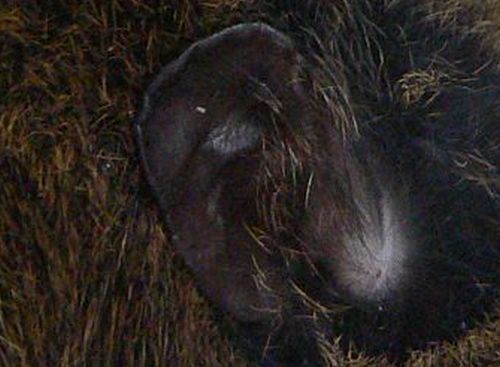
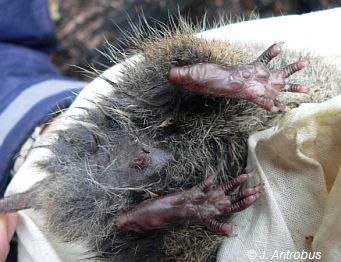
Distribution
The Broad-toothed Rat is distributed from sea level to >2200 m in elevation, and is climatically characterised by areas with a mean annual rainfall above 1000mm (Wallis et al. 1982).
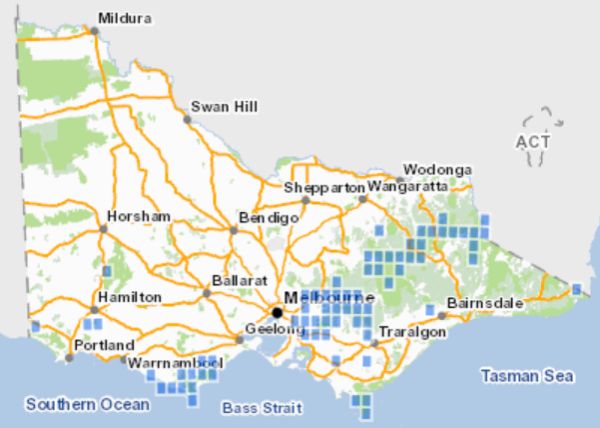
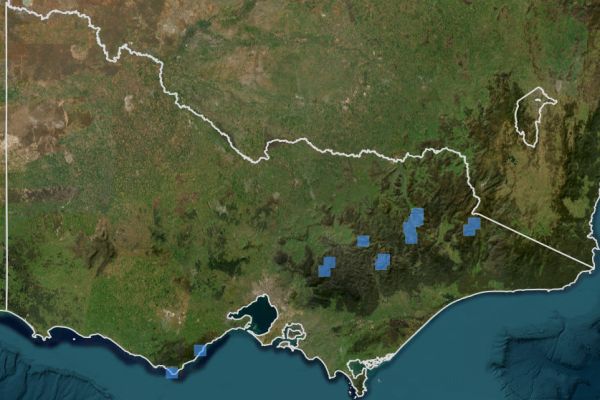
Records of Broad-toothed Rat 2000 to 2025. Interactive map. Source VVB 2025.
The Broad-toothed Rat has suffered a significant decline since the 1990’s. Surveys found they were not detected from 53% of Victorian sites at which they had been recorded prior to 1990 (Shipway et al. 2020)
Ecology & Habitat
The Broad-toothed rat is a terrestrial and mostly nocturnal rodent which inhabits high rainfall areas. They prefer a moderate-to-dense ground cover of grasses or sedges, with shrubs usually present (Happold, 1983), particularly along valley floors near to streams (Green et al. 2008).
Although the Broad-toothed Rat is found from coastal environments to high altitude areas its main strongholds are mostly in subalpine and alpine regions (Menkhorst et al. 2008).
Habitat in North East Victoria
At altitudes greater than 1200m the Broad-toothed Rat inhabits tall alpine herb-field, fern, valley bog, heath and woodland (Costin et al. 1970). At lower altitudes in South Gippsland Highlands and the Great Dividing Range the Broad-toothed Rat inhabits areas with a dense wet understorey within tall open-forest and open-forest communities (Wallis et al. 1982). The understorey may be patches of sedgeland and fernland on creek flats where there is a gap in the forest canopy or thickets of Tetrarrhena juncea, Rubus sp. and ferns beneath the canopy (Wallis et al. 1982).
Habitat in south-west Victoria
Near the coast in the Otways, the Broad-toothed Rat has been found in heath communities at Carlisle River (Seebeck, 1971), Moonlight Head (Menkhorst, 1995), and Parker River near Cape Otway (VFD 2007). In the Otway region of Victoria it can also be found in mountain ash tall open-forest, fern gullies, mixed open-forests, coastal and inland wet heaths (Emison et al. 1975; Seebeck, 1971; Wallis et al. 1982). Features common to most occupied sites include a dense ground layer of grasses, sedges and herbs (Wallis et al. 1982).
Feeding
The Broad-toothed Rat is a specialist herbivore which feeds on the stem, leaves and seeds of sedges and grasses, primarily Graminae and Cyperaceae (Watts & Braithwaite, 1978; Braithwaite et al. 1978; Wallis et al. 1982; Carron et al. 1990; Happold, 1983; Menkhorst, 1995). It is especially likes eating grasses in the Poa genus.
Breeding
The Broad-toothed Rat has low fecundity, low mortality and high adult and juvenile survival (Carron, 1985; Happold, 1989). Breeding occurs in spring and summer, the gestation period is 35 days and females have small litters, usually two offspring which have relatively slow growth. Males are driven from the nest by the female when young are born (Hyett & Shaw, 1980). In winter, in subalpine habitats where snow covers the ground, males and females are found huddled together in communal nests (Bubela & Happold, 1993).
Movement
Research at Mt Buller Alpine Resort found the Broad-toothed Rat typically has a small day to day home range around 3,000 sq. m with a small core area about 350 sq. m (less than 20m distance), but is known to periodically undertake longer movements of 500 m to 1000m. They have also been recorded to be capable of crossing a wide (200–300 m) grassy ski run (Whisson et al. 2015).
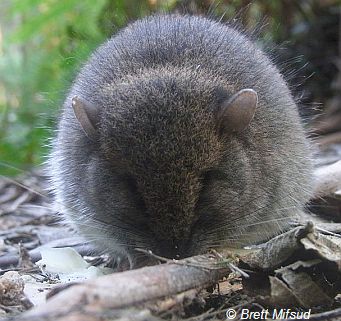
Population Status
In May 2016, the Broad-toothed Rat conservation status was elevated from Near Threated to being Listed as Vulnerable under the EPBC Act 1999 .
In Victoria, the conservation status of Broad-toothed Rat was re-assessed from Endangered in 2013 (DSE 2013) to Vulnerable in 2020 as part of the Conservation Status Assessment Project – Victoria (DELWP 2020). This species is now listed as Vulnerable in Victoria and under the Flora and Fauna Guarantee Act 1988 - Threatened List - March 2025.
Threats
The most critical threats to rodent populations in Victoria are considered to be;
- lack of active habitat management for those species that require early seral stages in vegetation
- predation by introduced carnivores
- fragmentation of species into small genetically isolated populations (Seebeck & Menkhorst, 2000).
Introduced predators
The Red Fox and Feral Cat are regarded as significant predators of the Broad-toothed Rat. A study which analysed fox scats also indicates that the Broad-toothed Rat is consumed at a much greater rate than the Bush Rat where these species co-exist (Green 2002). The impact of processes such as habitat loss, change and fragmentation can be exacerbated by cat and fox predation on remnant and isolated populations (Seebeck & Clunie, 1997)
In a study of fox diet over 3 years at both alpine and subalpine altitudes it was found foxes selectively prey on the broad‐toothed rat (Mastacomys fuscus Thomas) relative to the bush rat (Rattus fuscipes) (Green 2002).
Habitat fragmentation
Populations of the Broad-toothed Rat in Victoria already suffer from fragmentation, particularly between south-west Victoria (Otways and the Naringal area), north-east Victoria and south Gippsland. Loss of connecting habitat through agricultural, urban and rural developments has isolated populations in these areas of Victoria. Seebeck et al. 1997 noted that when a species exists only as small populations, there is the potential for loss of genetic variation and potentially a decreased resilience to cope with environmental change and stochastic events.
Habitat loss
Activities which remove or substantially alter dense thickets of grasses, sedges and herb understory vegetation such as grazing, wildfire, fuel reduction burning and clearing can impact on the viability of the Broad-toothed Rat. In cases of burning and grazing it is important to maintain areas of refuge habitat from which populations can recolonise if and when habitat becomes suitable again.
Habitat degradation due to feral horses, rabbits, deer, hares and pigs poses a problem (Menkhorst et al. 2008)
Climate change
Research suggests one of the impacts from climate change will be a reduction in habitat and increased competition from other species such as the Swamp Rat Rattus lutreolus. Climate change with a 20% reduction in precipitation and a warming of 2.9°C at latitude 36°S (Snowy Mountains) and 3.4°C at 42°S (central Tasmania) suggests that the Broad-toothed Rat will retreat to higher altitudes whilst core areas of the Swamp Rat will change and they will invade current core areas of the Broad-toothed Rat (Green et al. 2008).
Conservation of Broad-toothed Rat in Victoria
Key Parks and reserves
- Alpine National Park
- Baw Baw National Park
- Dandenong Ranges National Park
- Great Otway National Park & Otway Forest Park
- Mitchell River National Park
- Moondarra State Park
- Mt Buller Conservation Reserve
- Mt Buffalo National Park
- Port Campbell National Park
- Tarra Bulga National Park
- Wilsons Promontory National Park
- Yarra Ranges National Park
Key Local Government Areas (Number of records) Source: ALA (2019)
- Yarra Ranges (61)
- Alpine (49)
- Colac Otway Shire (44)
- East Gippsland Shire (35)
- Baw Baw Shire (32)
- Towong Shire (17)
- Murrindindi Shire (16)
- Mansfield Shire (7)
- South Gippsland Shire (6)
Projects & Partnerships
A combined research project looking at the distribution of Broad-toothed Rat in Victoria was undertaken in 2021. Project partners include: Zoos Victoria, Parks Victoria, Museums Victoria, WWF, Deakin University, Mt Hotham Resort and Falls Creek Resort.
Surveys included both scat and remote camera surveys in areas of previous records and modelled (predicted habitat). Scat surveys have proven to be a very cost-effective way of detecting the presence of Broad-toothed Rats. The fresh Broad-toothed Rat scats are quite different to any other small mammal scat as they are bright green in colour when fresh and distinctly white coloured when old.
2019/20 bushfire impacts surveys
The 2019/20 East Gippsland bushfires had a significant impact on populations of the Broad-toothed Rat, particularly in the alpine grassland and heath and, sub-alpine woodlands. Modelling of Broad-toothed Rat habitat in Victoria found 23% of its habitat was within the burnt area with 15% affected by high-severity fire (Macak & Rowe 2022).
Targeted surveys at Mount Hotham and surrounds were carried out post 2019/20 bushfire. Broad-toothed Rats were found in 69% of unburnt sites whilst none were found at burnt sites. In the eastern section of the Alpine National Park, Broad-toothed Rats were detected 67% unburnt sites surveyed in suitable treeless alpine grassland, heathland, and peatland habitats whilst Broad-toothed Rats were only detected in 25% of the burn sites (Macak & Rowe 2022).
Alpine resorts
A study at the Mt Buller Alpine Resort looked at identifying Broad-toothed Rat habitat, movement and home ranges close to ski runs. Fecal pellet surveys were carried out in 2009 and radiotracking occurred between October 2009 to March 2010. It was found the Broad-toothed Rat only occurs in areas where a dense cover of indigenous vegetation is present. Continued persistence of this species at the Mt Buller Alpine Resort will rely on maintaining, and possibly enhancing, the ability of the Broad-toothed Rat to move across the landscape. (Whisson et al. 2015).
Lake Mountain – DSE monitored habitat loss due to fire 2009/2010.
Lake Mountain - 1990,s study of predator scats (70 scats analysed) 50% of rattus results were broad toothed rat.
Mt Buller Conservation Reserve - surveys have been undertaken to increase knowledge, biology and ecology for management in 2008/2009.
Mt Stirling alpine resort: surveys carried out in 2007/2008 and 2008/2009.
Post fire surveys at Mt Buller Conservation Reserve & Lake Mountain Plateau.
Area resurveyed in 2021 as part of a combined research project.
Yarra Ranges National Park
Surveys conducted between Parks Victoria & Ecology Partners March & April 2010.
Area resurveyed in 2021 as part of a combined research project.
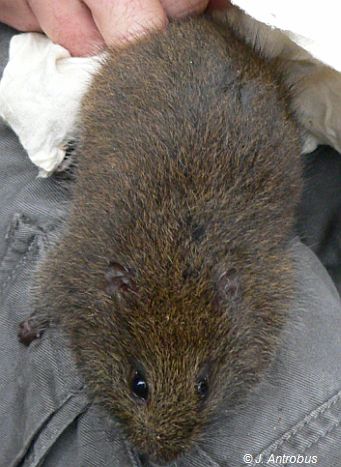
Otways
Periodic surveys of Broad-toothed Rat have been conducted around Cape Otway and Great Otway National Park by The Conservation Ecology Centre – Cape Otway.
A Deakin University PhD student undertook surveys in the Cape Otway area in 2014.
Surveys were conducted in the Otways in April 2022 as part of a combined project. In four days of surveys the number of records was tripled with many new sites being found.
Surveys in the Great Otway National Park (Sheoak Creek valley) between 2014 -2017 recorded Broad-toothed Rat which was the first available record of this threatened species in this section of the Great Otway National Park. Source: Peter Homan, Consultancy.
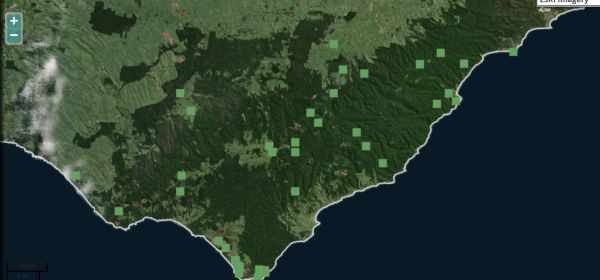
References & Links
ALA (2019) Atlas of Living Australia, Accessed 8 February 2019
Braithwaite, R.W., Cockburn, A. and Lee, A.K. (1978). Resource partitioning by small mammals in lowland heath communities in South-eastern Australia. Australian Journal of Ecology 3, 423-45.
Bubela, T.M., & Happold, D.C.D. (1993) The social organisation and mating system of an Australian subalpine rodent, the broad-toothed rat, Mastacomys fuscus Thomas, Wildlife Research 20(4) 405 - 417
Carron, P. L. (1985) The ecology of three species of small mammals in subalpine habitat. Ph.D. Thesis, Australian National University, Canberra.
Carron, P. L., Happold, D. C. D., Bubela, T. M., (1990) Diet of Two Sympatric Australian Subalpine Rodents, Mastacomys fuscus and Rattus fuscipes, Australian Wildlife Restoration, 17, 479-89.
Costin, A. B., Gray, M., Totterdell, C. J., Wimbush, D. J. (1979). Kosciusko Alpine Flora. CSIRO/Collins Sydney.
CSIRO (1995) Australian Names for Australian Rodents, (Brathwaite et al. 1995) Australian Nature Conservancy Agency.
DELWP (2020) Provisional re-assessments of taxa as part of the Conservation Status Assessment Project – Victoria 2020, Department of Environment Land Water and Planning, Victoria.
DSE (2013) Advisory list of threatened vertebrate fauna in Victoria, Department of Sustainability & Environment, East Melbourne.
Emison, W. B., Porter, J. W., Norris, K. C., Apps, G. J. (1975) Ecological distribution of vertebrate animals of the Volcanic Plains-Otway Range area of Victoria. Fisheries and Wildlife paper no 6.
FFG Threatened List (2025) Flora and Fauna Guarantee Threatened List, Department of Energy, Environment and Climate Action (DEECA), Victoria.
Green, K. (2002), Selective predation on the broad-toothed rat, Mastacomys fuscus (Rodentia: Muridae), by the introduced red fox, Vulpes vulpes (Carnivora: Canidae), in the Snowy Mountains, Australia. Austral Ecology, 27: 353–359. doi: 10.1111/j.1442-9993.2002.tb00183.x
Green, K., Stein, J. A., Driessen, M. M, (2008) The projected distributions of Mastacomys fuscus and Rattus lutreolus in south-eastern Australia under a scenario of climate change: potential for increased competition? Wildlife Research, 35, 113–119.
Happold, D.C.D (1983) In: The Australian Museum Complete Book of Australian Mammals (Ed.Strahan, R.), pp. 422-423, Angus & Robertson Publishers.
Happold, D. C. D. (1989). Small mammals of the Australian Alps. Pp221-239 in The Scientific Significance of the Australian Alps. Ed. R. Good, Australian Academy of Science, Canberra.
Hyett J., Shaw, N. (1980) Australian Mammals, a field guide for New South Wales, Victoria, South Australia & Tasmania, Thomas Nelson Australia, Melbourne, Vic.
IUCN (2019) Woinarski, J. & Burbidge, A.A. 2016. Mastacomys fuscus. The IUCN Red List of Threatened Species 2016: e.T18563A22429430. Downloaded on 30 January 2019.
Macak, P. & Rowe, K. (2022). Broad-toothed Rat. In DELWP. Biodiversity response and recovery supplementary report: bushfire impacts on species in Victoria. Department of Environment, Land, Water and Planning, Melbourne, Victoria.
Menkhorst, P., Denny, M., Ellis, M., Driessen, M., Broome, L., and Dickman, C. (2008). Wildlife in a changing world: an analysis of the 2008 IUCN Red List of threatened species.
Menkhorst, P.W. (2001) A Field Guide to the Mammals of Australia, pp198-199, (Ed. Meagher, D.), Oxford University Press, Australia.
Menkhorst, P. W. Ed. (1995) Mammals of Victoria, Distribution, ecology and conservation, Oxford University Press, Melbourne.
Norris, K. C., Gilmore, A. M., Menkhorst, P. W. (1979) Vertebrate fauna of South Gippsland, Victoria, Mem. Nat. Mus. Vict. 40, 105-199
Plomley, NJB (1976) A Word List of the Tasmanian Aboriginal Languages.
Seebeck, J. H. (1971) Distribution and habitat of the broad-toothed rat, Mastacomys fuscus Thomas (Rodentia: Muridae) in Victoria, Victorian Naturalist, 88, 310-323.
Seebeck, J., Clunie, P. (1997) Predation of Native Wildlife by the Cat Felis catus, Action Statement No. 80, Flora & Fauna Guarentee Act, Department of Sustainability & Environment, Melbourne, Vic.
Seebeck, J., Menkhorst, P. (2000) Status and conservation of the rodents in Victoria, Wildlife Research, 27, 357–369.
Shipway et al. (2020) Persistence of the broad-toothed rat (Mastacomys fuscus) across Victoria is correlated with climate and elevation Wildlife Research 47(3) 267-278 CSIRO Publishing 2020.
TSC Act (1995) Threatened Species Conservation Act 1995'' No 101 – Accessed 7 February 2019.
VBA (2019) Victorian Biodiversity Atlas, Department of Environment, Land, Water and Planning, Victoria.
Wallis, R. L., Brunner, H., Menkhorst, P. W. (1982). Victorian field studies on the broad-toothed rat (Mastacomys fuscus Thomas), Victorian Naturalist, 99, 12-21.
Watts, C. H. S., Braithwaite, R. W., (1978) The diets of ''Rattus lutreolus'' and five other rodents in southern Victoria, Australian Wildlife Research, 5, 47-57.
Whisson, Desley A., Holland, Greg J. and Kelly, Thomas R. (2015) Persistence of a threatened species in a modified alpine resort environment: the broad-toothed rat Journal of mammalogy, vol. 96, no. 1, pp. 151-158,
More Information
SWIFFT Seminar notes -26 May 2022 - The status of the Broad-toothed Rat in Victoria
Australian Government - Species profile and threats database - Braod-toothed Rat / Tooarrana
Please contribute information regarding Broad-toothed Rat in Victoria - observations, images or projects. Contact SWIFFT

